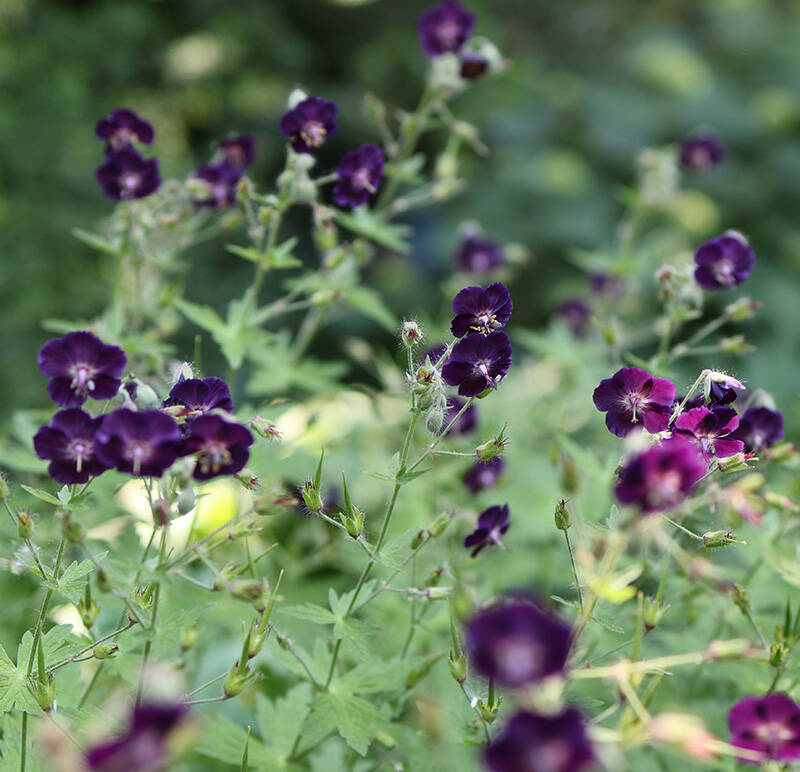We divide plants for two main reasons. First is to rejuvenate. As some plants grow older, they bloom less and are less vigorous. Dividing rejuvenates them. Second reason is to get more plants! If you love the plants you have, why buy more when you can make more? Fall is the ideal time to divide perennials. The cooler weather and the gradual fade to dormancy puts considerably less stress on plants. This is a good thing, because digging up and dividing plants can stress them out.
Photography by Joy Yagid.

Before you start digging up plants to divide, remember that not every plant can be divided—and of those that can be divided, fall may not be the best time to do it. In addition, how you divide them matters. Technique varies depending on the type of root system each plant has. Plants can have traditional roots (like black-eyed Susans), fibrous clumps (like ostrich ferns), rhizomes (like hostas), crowns (like Joe Pye weed), or tubers (like daylilies).
What You’ll Need

Once you know what can be divided and how, you need to make sure you have the proper tools. Beyond a good pair of garden gloves to protect your hands and maybe a tarp to contain the soil, you will need a garden spade or shovel, a spading fork (or two if you have a big job), a pair of pruners, and either a trowel or a hori hori knife (see Tools of the Trade: Japanese Garden Tools). The hori hori can do double duty as both a trowel and a knife and is the reason I prefer it. One less tool to carry.
A few large empty nursery pots will make it easier to move the divided plants around or to hold them for a few days until you decide what to do with them. Don’t let them dry out if you’re not replanting immediately. When you do replant, give them the best start by digging a hole one and a half to two times the size of the roots, back fill with good quality garden soil, and water deeply.
How to Divide Black-Eyed Susans (Traditional Roots)

Dig up the plant, going as wide and deep as possible to get as much of the root system as you can. If the plant is smaller, you can gently pull it apart with your hands. If it’s larger, take your shovel or hori hori knife and cut it into sections. How big of a section depends on how big of a plant you have. To be safe, the divisions should not be smaller than the size of your fist and have several stems. Once divided, trim back about a third of the top growth to lessen the stress of transplanting. If they are still in bloom, remove all the flowers, put them in a vase, and enjoy them when you are having your morning coffee. There’s no reason they should go to waste.
How to Divide Ferns (Fibrous Roots)

Fern roots are thick and look almost like tap roots, but they don’t go as deep. They require strength and a sharp knife. I struggled with them. It is hard to cut through their roots even with a very sharp hori hori. Dig the ferns up with a hori hori or trowel, leaving enough room so that you can get the root out in one piece. You can cut them in half with a sharp knife or your hori hori. Replant immediately and water generously.
How to Divide Hostas (Rhizome Roots)

Hostas grow outwards via their rhizomes. Once they start to encroach outside of their space in your garden, it’s time to make more hostas! Dig out the entire plant, giving a few inches of room around the base. Try to be careful not to damage the leaves if possible but don’t worry if you do. It’s late in their season and dormancy is around the corner. Then with the blade of your shovel, split the plant into sections. Each section should have at least one stalk of leaves, but two or three is better. Hostas are almost indestructible (deer excluded) and can last several days to even a week in a pile in the shade until you decide where to replant, as long as you don’t let them dry out. I have done this and they were no worse for wear.
How to Divide Joe Pye Weed (Crown Roots)

Plants with crown root systems grow outward and the crown gets larger and larger. You can get a bare spot in the center. Using a garden spade, loosen up the soil around the plant and lift up and out. Depending on the size, you may need help from another fellow gardener. You can use the spade or a knife to cut the crown into sections. Make sure each section has a few healthy stems. Trim off about a third of the top growth and replant.
How to Divide Daylilies (Tuberous Roots)

Daylilies are very tough plants and are simple to divide. Dig around the plant, about three inches around the fans and as deep as you can go. Daylilies can have very deep roots, which is make them drought resistant. Once you have the plant out, knock off as much soil as possible. Then simply work the individual fans apart with your hands and replant with the rhizomes just below the surface of the soil.
See also:
- Gardening 101: How to Divide Tall Bearded Irises
- September in the Garden: 8 Ways to Stretch the Season
- What to Do in the Garden in September
N.B.: This post was first published September 2023.












Have a Question or Comment About This Post?
Join the conversation (0)